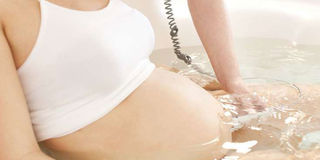Water births: Women report having less painful labour

Some women who go through water births report having less painful contractions during the first stage of labour, says gynaecologist. PHOTO | FOTOSEARCH
Over the past 10 years, more women in Kenya have been opting to deliver their babies through water births. Through this method an expectant woman can choose to labour in the water and get out for delivery or to stay in the water for the whole delivery.
The popularity of this alternative delivery method has been mainly driven by the relaxation and lesser labour pains provided by water births, says Dr Janet Thuthwa, an obstetrician/gynaecologist in private practice.
She says women who go through water births report having less painful contractions during the first stage of labour. “This is facilitated by the warm water in the delivery tub. That the baby has been in the amniotic sac for nine months also means that a water birth provides an almost similar and gentler environment for the baby,” she says.
The advantages have been echoed by a new medical research that examined water births and conventional vaginal births. The report says the two methods of delivery are equally beneficial to the mother and the baby. This means that while water births have previously not been considered a first option, they hold their own benefits to both the mother and the baby.
“There are no differences in the outcomes of water birth and normal vaginal birth for neonatal intensive care admissions and post-partum haemorrhage rates,” says Prof Lisa Kane who led the medical team of researchers at the University of Michigan’s School of Nursing.
COST AND ACCESSIBILITY
In most cases, during a water birth, expectant mothers are asked to leave the birth pool or tub just before delivery. This is due to the safety dilemma that continues to riddle the decision to have a full water birth or not. “The risks have been highlighted as including neonatal infections or cord tearing in some case studies,” she said.
The medical report says newborns take their first breath when removed from the tub. “Until then, their lungs are filled with water, which is displaced when they hit the air and breathe,” says the report.
The baby and the mother are brought out of the water almost immediately. This is usually before the placenta is delivered so that blood loss is more accurately calculated.
Dr Thuthwa says a water birth pool or tub usually contains warm water. “The process works with warm water, which is usually maintained at about 37 degrees Celsius to keep both the mother and the baby warm,” she says.
There are also several risk factors a mother ought to bear in mind when considering a water birth. “Water births are inappropriate where the risk of infections from diseases such as herpes is high, or where there is pre-eclampsia, unstable baby’s heartbeat and excessive bleeding,” says Dr Thuthwa. In Kenya some of a couple of private hospitals offer mothers the water birth option. The advent of water births in Kenya is, however, not expected to be an option for millions of rural women due to the costs and accessibility.
“Urban Kenyan women have a higher proportion of birth preparation, delivery options, and complication readiness in contrast to rural expectant mothers,” says Dr Thuthwa.
But with the benefits far outweighing the risks, water births are expected to boost the country’s endeavours at reducing mortality rate. Currently, maternal mortality remains alarmingly high at between 300 and 400 deaths per 100,000 live births in Kenya.
According to the Kenya Demographic and Health Survey, between 2007 and 2014, Kenya had a maternal mortality ratio of 362 deaths per 100,000 live births from 2007 to 2014. In 2017, the maternal mortality ratio was 342 deaths per 100,000 live births.


